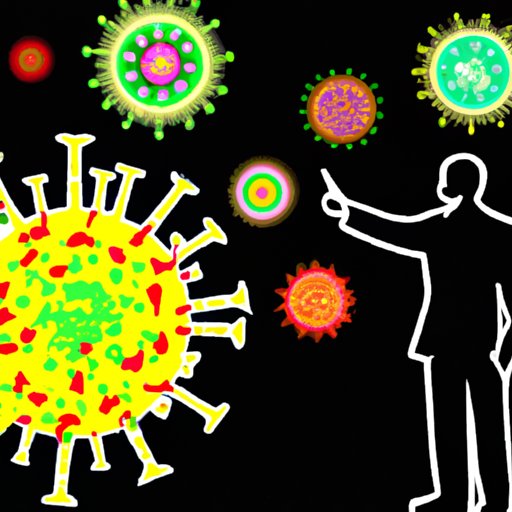
I. Introduction
When we think of viruses, we often associate them with diseases. However, it’s important to understand that viruses and diseases are not interchangeable terms. In this article, we will explore the relationship between viruses and diseases, their key differences, and why it’s important to understand these differences. In the current global health crisis, caused by the COVID-19 pandemic, understanding the relationship between viruses and diseases is particularly important for preventing the spread of disease worldwide.
II. Defining and Differentiating the Terms: “Virus” and “Disease”
A virus is an infectious agent that can only replicate inside a living cell. In contrast, a disease is a condition that impairs the normal functioning of an organism. While viruses and diseases are often closely related, they are not interchangeable terms.

III. Exploring the Relationship between Viruses and Diseases
Viruses can lead to diseases by invading and damaging host cells. Some common examples of viruses that lead to diseases include the flu and COVID-19. When a virus invades a host cell, it uses the host cell’s machinery to replicate itself and produce more virus particles. This can result in damage to the host cell and the surrounding tissue, leading to the development of a disease.
IV. The Science behind How a Virus Becomes a Disease
Viral replication is a complex process that involves the replication of viral genetic material and the assembly of new virus particles. The degree of damage that a virus can cause to host cells depends on a number of factors, including the type of virus, the host, and the immune response. Different viruses can lead to different types of diseases depending on these factors.
V. Pandemics and Their Association with Viruses and Diseases
Viral pandemics have had a significant impact on human history, with the current COVID-19 pandemic being the most recent example. Viruses are often responsible for pandemics because they can quickly spread around the world. The ease of global travel and the interconnectedness of the world’s population means that a virus can rapidly move from one part of the world to another, making it difficult to control the spread of disease.
VI. The Role of Vaccines in Preventing Viruses from Becoming Diseases
Vaccines work by stimulating the immune system to produce a response against a specific virus or bacteria. This response can help protect against future infections by the same pathogen. Vaccines have been successful in preventing widespread diseases, such as polio and measles. With the development of a COVID-19 vaccine, there is hope that this pandemic can be controlled in the future.
VII. Studying the Symptoms of Diseases Caused by Viruses
Common symptoms of viral diseases include fever, coughing, and fatigue. However, symptoms can vary depending on the virus and the individual. It’s important to monitor and track symptoms to prevent the spread of disease.
VIII. Panic versus Awareness: COVID-19 and Other Viruses That Turn into Diseases
The current COVID-19 pandemic has led to widespread panic and fear around the world. While it’s important to take appropriate actions to prevent the spread of disease, such as social distancing and wearing masks, it’s also important to avoid unnecessary panic. Other viruses, such as the flu, have also led to pandemics in the past, and it’s important to stay informed and take appropriate actions without causing unnecessary panic.
IX. Conclusion
Understanding the difference between viruses and diseases is important for preventing and treating diseases in the future. Viruses can lead to diseases by invading and damaging host cells, and different viruses can lead to different types of diseases depending on a number of factors. Pandemics caused by viruses have had a significant impact on human history, and vaccines have been successful in preventing their spread. By staying informed and taking appropriate actions, we can work to control the spread of disease while avoiding unnecessary panic.




